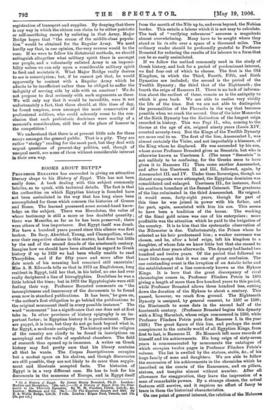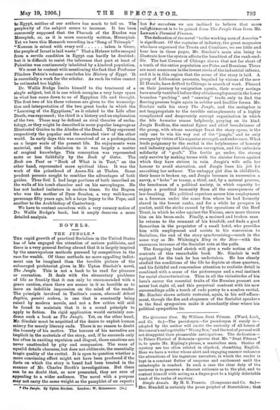BOOKS ABOUT EGYPT.* PROFESSOR BREASTED has succeeded in giving an
attractive literary shape to his History of Egypt. This has not been easily done. A book dealing with this subject commonly bristles, so to speak, with technical details. The fact is that the authorities on which Egyptian history is founded have not been assimilated in the way that has long since been accomplished for those which concern the histories of Greece and Rome. The learned possessed some second-band know- ledge on the subject. There was Herodotus, the value of whose testimony is still a more or less doubtful quantity ; there was Manetho, as far as he has been preserved ; there were others of less importance. But Egypt itself was dumb. Nor have a hundred years passed since this silence was first broken. De Sacy, Akerblad, Young, and Champollion, what- ever their respective claims in this matter, had done but little by the end of the second decade of the nineteenth century. Imagine how we should have been situated in regard to Greek history if up to 1820 we had been wholly unable to read Thucydides, and if for fifty years and more after that date much of his meaning had remained still uncertain! Miss A. B. Edwards tells us that in 1873 an Englishman, long resident in Egypt, told her that, in his belief, no one had ever really deciphered a line of hieroglyphics. Doubtless he was a little behind the time; but in 1873 the Egyptologists were still feeling their way. Professor Breasted comments on " the incompleteness and inaccuracy of the documents to be found even now in standard publications. It has been," he goes on, " the author's first obligation to go behind the publications to the original monument itself in every possible instance." The word "monument" has a significance that one does not at first take in. In other provinces of history epigraphy is an im- portant factor; in Egyptian history it is predominant. There are papyri, it is true, but they do not go back beyond what is, for Egypt, a moderate antiquity. The history and the religion of the country are chiefly to be found in inscriptions on sarcophagi and the walls of sepulchral chambers. The field of research thus opened up is immense. A writer on Greek history may feel pretty sure that his library contains all that he wants. The Corpus Inscriptionuns occupies but a modest space on his shelves, and though discoveries are still possible, they are not likely to do more than supple- ment and illustrate accepted facts. The historian of Egypt is in a very different case. He has to look for his documents in the museums of Europe, and in Egypt itself
• (1) 4 History of Egyc By James Henry Breasted, Ph.D. London : Hodder and Stoughton. 20s. net.]—(2) A History of Egypt from the Nine- teenth to the Thirtieth nastier. Bio W. M. Flinders Petrie, Litt.D., de. London : Methuen and Co. [6e.]— 3) The Egyptian Heaven and Hell. By
E. A. Wallis Budge, Litt.D. 3 vols. ndon : /Keg= Paul, Trench, and Co. [6s, per gold
from the mouth of the Nile up to, and even beyond, the Nubian border. This entails a labour which it is not easy to calculate. The task of "verifying references" assumes a magnitude almost overwhelming. Many have to be sought where they stand or lie in situ over a space of a thousand miles. The ordinary reader should be profoundly grateful to Professor Breasted for reducing the results of his labours to a form that can be so easily assimilated.
If we follow the method commonly used in the study of Greek history, and look for a period of predominant interest, we find four out of which to choose. The first is the Old Kingdom, in which the Third, Fourth, Fifth, and Sixth Dynasties are included; the second is the period of the Twelfth Dynasty; the third that of the Eighteenth ; the fourth the reign of Rameses II. There is no lack of informa- tion about the earliest of these, remote as is the antiquity to which it goes back. We are able to realise very vividly the life of the time. But we are not able to distinguish the personalities of the Pharaohs in the way that becomes
possible when we reach the second. One of the later Monarchs of the Sixth Dynasty has the distinction of the longest reign recorded in history. This was Pepi II., who, coming to the throne at the age of six, reigned ninety years (Louis XIV. counted seventy-two). But the Kings of the Twelfth Dynasty are more real to us. The first of the line, Amenemhet I., was almost certainly the Vizier, and not improbably a kinsman, of the King whom he displaced. He was succeeded by his son, whose name Professor Breasted gives as Sesostris, but who is otherwise known as Usertesen I. (The name "Sesostris" is not unlikely to be confusing, for the Greeks seem to have given it to Rameses II.) Then came another Amenemhet, and after him Usertesen IL and III., followed, again, by Amenemhet III. and IV. Under these Sovereigns, though no distant conquests were attempted, the Egyptian dominion was consolidated and enlarged. Usertesen III., for instance, fixed his southern boundary at the Second Cataract. The greatness of the line culminated in the third Amenemhet. He reigned, it would seem, forty-eight years, though for part of this time he was joined in power with his father, and for part, again, associated with him his son. This seems to have been a tradition of the house. The working of the Sinai gold mines was one of his enterprises ; more profitable was the attention which he paid to the irrigation of the country. It is to him that the systematic observation of the Nilometer is due. Unfortunately, the Prince whom he selected as his heir predeceased him ; a weaker successor was chosen, and he, after a brief reign, left his kingdom to a daughter, of whose fate we know little but that she ceased to reign about four years afterwards. The dynasty had lasted two hundred and twelve years. Of the period that followed we know little except that it was one of great confusion. The one outstanding event is the irruption of an Asiatic tribe and the establishment of a line commonly known as the Hyksos Kings. It is here that the great discrepancy of rival chronologies comes in, Professor Flinders Petrie in 1894 giving a length of more than five hundred years to this period, while Professor Breasted allows three hundred less, cutting down the duration of the Hyksos to about a century. This passed, however, we reach firm ground. The Eighteenth Dynasty is assigned, by general consent, to 1587 or 1580; the Nineteenth to some date in the second half of the fourteenth century. (Professor Breasted begins this dynasty with a King Harmhab, whose reign commenced in 1350, while Professor Flinders Petrie puts first Rameses L in the year 1328.) The great figure of this line, and perhaps the most conspicuous to the outside world of all Egyptian Kings, from first to last, is Rameses II. No Monarch left more records of himself and his achievements. His long reign of sixty-seven years is commemorated by monuments the catalogue of which occupies twelve pages in Professor Flinders Petrie's volume. The list is swelled by the statues, steles, &c., of his huge family of sons and daughters. We are able to follow the succession of his achievements in the chronicles which he inscribed on the courts of the Rameseam, and on pillars, statues, and temples almost without number. After all allowance for exaggeration, they leave the impression of a man of remarkable powers. By a strange chance, the actual features still survive, and it requires no effort of fancy to trace in them the historical characteristics.
On one point of general interest, the relation of the Hebrews
to Egypt, neither of our authors has much to tell us. The perplexity of the subject seems to increase. It has been commonly supposed that the Pharaoh of the Exodus was Meneptah, or, as it is more correctly written, Merneptah- Yet we have this Monarch recording in a "Song of Triumph" "Kanaan is seized with every evil taken is Gezer, the people of Israel is laid waste." That a Hebrew tribe escaped from a servile condition in Egypt can hardly be doubted ; but it is difficult to resist the inference that part at least of Palestine was continuously inhabited by a kindred population.
We must be content with mentioning the fact that Professor Flinders Petrie's volume concludes his History of Egypt. 'It is essentially a work for the scholar. As such its value cannot be estimated too highly.
Dr. Wallis Budge limits himself to the treatment of a single subject, but it is one which occupies a very large space in what has come down to us of Egyptian life and thought. The first two of his three volumes are given to the transcrip- tion and interpretation of the two great books in which the "Learning of the Egyptians," as it related to the Life after Death, was expressed ; the third is a history and an explanation of the two. These may be defined as rival theories of escha- tology, or they might be described in more popular language as Illustrated Guides to the Abodes of the Dead. They represent respectively the popular and the educated view of the other world. In early days this was conceived of as a prolongation on a larger scale of the present life. Its enjoyments were material, and the admission to it was largely a matter of magical knowledge. This conception was represented mere or less faithfully by the Book of Gates. The Book am Tuat or " Book of What is in Tuat," on the other hand, represented more spiritual ideas. It was the work of the priesthood of Amen-Rd at Thebes. Some prudent persons sought to combine the advantages of both guides. Thus Seti L had large portions of both inscribed on the walls of his tomb chamber and on his sarcophagus. He has not lacked imitators in modern times. So the Begum who was the mother of Dyce Sombre, a very well-known personage fifty years ago, left a large legacy to the Pope, and another to the Archbishop of Canterbury.
We have to content ourselves with a very cursory notice of Dr. Wallis Budge's book, but it amply deserves a more detailed analysis.











































 Previous page
Previous page